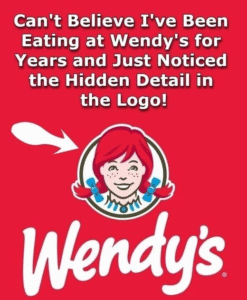Most People Miss This Hidden Detail in the Wendy’s Logo: A Closer Look at Branding Genius
Logos are the silent ambassadors of brands. They communicate identity, values, and personality without uttering a single word. Among the countless logos in the fast-food industry, Wendy’s stands out—not just for its cheerful red-haired mascot but for a clever hidden detail that most people overlook. This hidden element exemplifies the power of thoughtful design in marketing and demonstrates how even seemingly simple logos can carry rich layers of meaning. Understanding the subtlety behind Wendy’s logo offers insights into branding, consumer psychology, and the art of visual storytelling.
The Iconic Wendy’s Logo
The Wendy’s logo is instantly recognizable: a smiling, freckled girl with red braids, wearing a blue-and-white collar against a red background. Named after Wendy Thomas, the daughter of Wendy’s founder Dave Thomas, the mascot’s likeness is both personable and approachable. It conveys friendliness, reliability, and a sense of home-cooked comfort—all qualities the fast-food chain wants to associate with its brand.
On first glance, the logo appears straightforward—a friendly portrait of a young girl meant to evoke warmth. However, a closer inspection reveals a clever and subtle design element that many consumers miss.
The Hidden Detail: The Word “Mom”
Perhaps the most fascinating hidden detail in the Wendy’s logo is the word “Mom” subtly integrated into Wendy’s collar. If you look closely at the white lines on the collar, you can see the word cleverly formed, almost like a secret signature embedded by the designers. This design choice is more than a clever trick—it reinforces the brand’s messaging in a subtle, subconscious way.
The presence of the word “Mom” aligns with Wendy’s marketing philosophy of home-style meals and family-friendly dining. By embedding this word into the logo, the brand signals warmth, comfort, and homemade quality, subtly connecting the consumer to feelings of nostalgia and care. Even if people don’t consciously notice the hidden word, it can still influence perceptions, tapping into the psychological associations of maternal care and home-cooked meals.
The Psychology Behind Hidden Logo Elements
Hidden elements in logos are not merely aesthetic choices—they are powerful psychological tools. Designers use these details to create an “aha” moment for viewers, generating curiosity and engagement. In the case of Wendy’s, the hidden “Mom” contributes to several branding objectives:
-
Emotional Connection: Hidden elements often evoke surprise and delight when noticed. For Wendy’s, discovering the word “Mom” can elicit feelings of warmth and personal connection, aligning with the emotional appeal of comfort food.
-
Brand Recall: Logos with hidden details tend to be more memorable. Consumers may not notice the hidden word initially, but once it is pointed out, it creates a lasting impression and encourages sharing—both online and offline.
-
Subconscious Messaging: Even without conscious recognition, visual cues can influence consumer perception. The association with “Mom” subtly reinforces the idea of care, trust, and homemade quality.
-
Differentiation: In a crowded fast-food market, a logo with depth and clever design elements sets a brand apart, signaling attention to detail and creativity.
A History of Hidden Details in Logos
Wendy’s is not alone in using hidden messages in branding. Many iconic logos contain subtle elements designed to communicate something deeper:
-
FedEx: Perhaps the most famous example, the FedEx logo features a hidden arrow between the letters “E” and “x,” symbolizing speed and precision.
-
Amazon: The Amazon logo includes a curved arrow from “A” to “Z,” indicating the company sells everything from A to Z, while also resembling a smile.
-
Toblerone: The Toblerone chocolate logo features a hidden bear within the mountain, a nod to Bern, Switzerland, the brand’s origin.
These hidden details create engagement, intrigue, and brand storytelling—all of which Wendy’s leverages with its subtle “Mom” inclusion.
The Marketing Genius of Wendy’s Logo
Dave Thomas, the founder of Wendy’s, was known for his personal approach to marketing. He often emphasized family values, quality, and trust, qualities that remain central to the brand. The logo, featuring Wendy herself, captures this philosophy by putting a human face to the chain. Embedding a subtle detail like “Mom” reinforces these values in a quiet yet powerful way.
By connecting to feelings of home and maternal care, the logo creates a brand identity that contrasts with competitors who focus primarily on speed, price, or indulgence. Wendy’s positioning is about warmth, reliability, and a personal touch—a “fast-food restaurant with heart.” The hidden detail amplifies this message, showing that the brand pays attention to both the big picture and the tiniest details.
Consumer Engagement and Social Media
Hidden details in logos have also become fertile ground for social media engagement. When consumers discover the word “Mom” in Wendy’s logo, it often goes viral, with people sharing screenshots, memes, and posts highlighting the hidden element. This type of engagement is free marketing and reinforces brand loyalty.
Moreover, discussions around hidden logo elements spark curiosity and brand exploration. A customer who notices the detail may be prompted to learn more about Wendy’s history, menu offerings, or marketing philosophy. This indirect engagement strengthens brand awareness and creates a more immersive consumer experience.
Lessons for Branding and Design
Wendy’s logo serves as a case study in the importance of thoughtful design and strategic branding. Several lessons can be drawn:
-
Every Detail Matters: Even small, subtle elements in a logo can communicate core values and contribute to brand identity. Designers must consider both conscious and subconscious messaging.
-
Emotional Storytelling: Successful logos often tell a story beyond the surface. By embedding “Mom,” Wendy’s evokes comfort, trust, and home-cooked quality.
-
Encourage Discovery: Hidden elements create engagement and curiosity. Logos that reward close inspection foster deeper consumer interaction.
-
Consistency with Brand Values: The logo’s messaging should align with broader brand positioning. Wendy’s emphasis on personal touch, family values, and quality is perfectly complemented by the subtle hidden detail.
-
Viral Potential: Clever design choices can create organic social media buzz, spreading brand awareness without direct advertising spend.
The Broader Impact on Fast-Food Branding
Wendy’s approach demonstrates that logos are not just visual symbols but powerful tools of narrative and emotional connection. In the competitive fast-food industry, where menus, prices, and advertising campaigns can be similar across brands, subtle branding elements can create differentiation. A clever logo detail may seem minor, but it contributes to long-term brand equity, consumer loyalty, and market positioning.
Competitors may take note, recognizing that branding is about more than colors and fonts—it is about crafting an identity that resonates on multiple levels. Wendy’s hidden “Mom” detail exemplifies how a single, well-placed design choice can reinforce values, spark conversation, and enhance the consumer experience.
Conclusion
Most people overlook the hidden word “Mom” in the Wendy’s logo, but this subtle detail is a masterclass in thoughtful branding. Beyond being a visual curiosity, it communicates warmth, care, and a sense of home, aligning perfectly with the brand’s identity. The logo is a reminder that effective branding combines creativity, strategy, and emotional resonance, creating a connection with consumers that goes far beyond the surface.
In the competitive world of fast food, where menu items, pricing, and promotions may shift, the Wendy’s logo remains a constant, quietly conveying the chain’s commitment to family values, quality, and personal touch. By embedding meaning in a detail that most people miss, Wendy’s demonstrates that good design is not just seen—it is felt. Consumers may never consciously notice every hidden element, but the impact of thoughtful design resonates subconsciously, shaping perceptions, loyalty, and the overall brand experience.
The lesson is clear: in branding, small details matter, and sometimes, what you don’t see at first glance makes all the difference. Wendy’s logo, with its secret nod to “Mom,” is a testament to the power of subtlety, storytelling, and emotional connection in creating a lasting brand legacy.


